Alien Nummo and the Dogon
BLOG INDEX
Splendor of the Sun
Splendor Solis Updated June 4, 2023
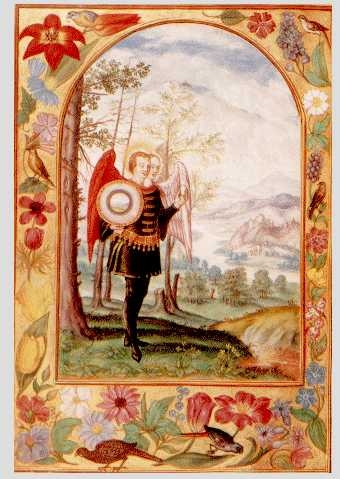 Splendor Solis 15th c. ©Shannon DoreyShannon Dorey, Day of the Fish, p. 346 |
This is Plate IX of the manuscript, Splendor Solis (Splendor of the Sun), which shows a two-headed hermaphrodite with one red and one white wing holding a circular mirror in one hand and an egg in the other.Shannon Dorey, Day of the Fish, p. 346 The red and white colours essentially identify opposite aspects of the same essence. The Nummo were hermaphrodites and identified as twins, with one side female and the other male. This is found in many ancient cultures including the Celtic cultures.
In The Nummo I refer to the importance of the colours red and white as the Dogon associated the colour red with a red giant sun, which was a symbol of life; and the colour white with a white compact star, a symbol of death. Shannon Dorey, The Nummo, p. 9
A white compact star is what is left after a large red giant star or sun has expelled all of its gas to create a nebula, which is a stellar nursery where all life is created. It is for this reason that the Dogon perceived a red sun as a pregnant sun. The colour red was therefore a female symbol and the colour white, a male symbol, which is the opposite to how the hermaphrodite is depicted in this illustration.Shannon Dorey, The Nummo, p. 8
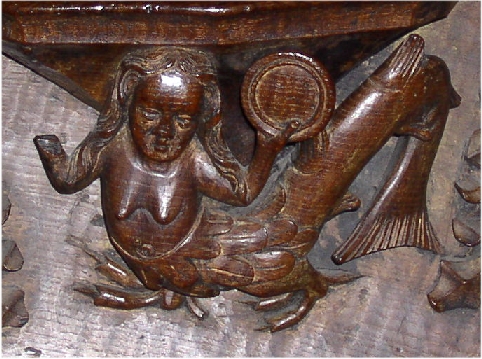 Mermaid Misericord 15th c.Shannon Dorey, The Nummo, p. 153 |
The depiction of the hermaphrodite holding a mirror associates this figure with images of mermaids holding mirrors on misericords found carved on the underside of the hinged seats of choir-stalls in medieval churches and cathedrals. This carving shows a mermaid misericord at Carlisle Cathedral dated to the 15th century. Besides being hermaphrodites, the alien Nummo had fish tails. The picture of The Penitent Magdalene, which was painted sometime between 1625 and 1650 by Georges de la Tour, shows her with a red skirt shaped like a fish tail looking into a mirror. Mermaids holding mirrors also appear in the watermarks of the Albigensians that were referred to in The Nummo and Day of the Fish.Shannon Dorey, Day of the Fish, p. 283 and The Nummo p. 153.
The main character of Splendour Solis is Solomon Trismosin, Adept and Teacher of Paracelsus and the book is an autobiographical account of his travels in search of the Philosopher's Stone. Paracelsus was born as Philippus Aureolus Theophrastus Bombastus von Hohenheim on 11 November or 17 December in 1493 in Einsiedeln, Switzerland, and died on 24 September in 1541 in Salzburg. He was a "Renaissance physician, botanist, alchemist, astrologer, and general occultist."
The manuscript was written in a language identified as Central German and reveals the alchemical death and rebirth of the king.Shannon Dorey, Day of the Fish, pp. 346-348 In the introduction to the manuscript the author says, that the process (referring to the alchemical death and rebirth) "stretches through the History of Alchemy like a Sea-serpent." The author continues,
The Sea-serpent may be a living aquatic monster that has survived the Deluge and other Cataclysms in some deep cave. It is with the Philosopher's Stone as with the Sea-serpent, some say they have seen it, while the whole mass of mankind [humanity] has not; but the evidence of the few who have seen, outweighs the opinion of the many who may have not. A thing still is, though people know nothing about it. Like Argon or Neon, it may be universal, and remain universally unknown, yet, nevertheless, it exists.Shannon Dorey, Day of the Fish, p. 348
This passage suggest that some Nummo still inhabited the Earth and were known to a few individuals in the 1500s.Shannon Dorey, Day of the Fish, p. 348 In Chapter 22 of Day of the Fish, I refer to the 10th-century document, the Canon Episcopi, which describes how groups of women met at night to worship the pagan goddess Diana (Greek Artemis), and believed that they would ride in processions upon beasts led by Diana across "great spaces of the Earth."
The Greek Goddess Artemis (Roman Diana) was described as having a fish tail in some accounts and appears in statues from Ephesus in Turkey with a fish tail. Did the Nummo still interact with humans right up until the witch trials in the fifteenth century? These associations help to confirm that what is known to us today as the Dogon religion was practised throughout Europe before the witch trials.Shannon Dorey, Day of the Fish, pp. 286-289
My research would tend to support Margaret Murray's premise that the consistency of the stories from those convicted of witchcraft were evidence of a wide-spread pre-Christian religion existing in Europe. While the earliest witch trial occurred in 1324, the peak of the witch hunt was between 1580 and 1630 and the last known trial occurred in 1782. J.B. Hare describes some of Murray's conclusions.
Murray, upon examination of the evidence, concluded that as barbaric as the witch trials were, they were conducted according to long-established legal procedures; that there was material evidence, witnesses corroborated each other, and (perhaps most tellingly) that not all confessions were extracted under torture. In some cases the accused testified willingly. They even went to their deaths unrepentantly insisting that their faith was the true religion and Christianity was false.Shannon Dorey, Day of the Fish, p. 248
My research indicates that the Dogon religion, which is associated with the pre-Christian religion, was likely the source of Christianity, supporting the claims of those who were murdered by the Inquisition. In the introduction to her book, The Witch-Cult in Western Europe, Murray states,
The deity of this cult was incarnate in a man, a woman, or an animal; the animal form being apparently earlier than the human, for the god was often spoken of as wearing the skin or attributes of an animal. At the same time, however, there was another form of the god in the shape of a man with two faces. Such a god is found in Italy (where he was called Janus or Dianus), in Southern France (see pp. 62, 129), and in the English Midlands.
The feminine form of the name, Diana (Artemis), is found throughout Western Europe as the name of the female deity or leader of the so-called Witches, and it is for this reason that I have called this ancient religion the Dianic cult.Shannon Dorey, Day of the Fish, p. 286
Sir James George Frazer published The Golden Bough in 1922, and it is evident that fragments of this old religion were still being practiced in various parts of Europe at that time.Shannon Dorey, Day of the Fish, p. 257
For more information on the Dogon religion refer to my books, The Master (Mistress) of Speech, The Nummo, Day of the Fish and The Rose.
The First Human
Anubis and Stolen Fire, Jan. 10, 2023
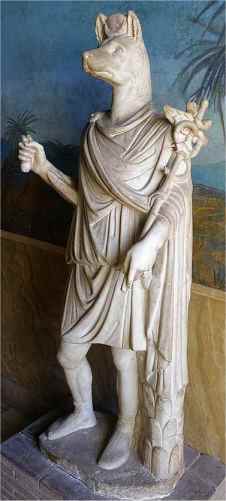 Anubis with CaduceusBy Daderot - Own work, Public Domain, https://commons.wikimedia.org/w/ index.php?curid=79299404 |
My research reveals that Anubis, the jackal-god of ancient Egypt, was the same thieving Jackal described by the Dogon elder Ogotemmêli and identified as the first human. Ogotemmêli related the Jackal to death. His roof dance prefigured funeral rites.Shannon Dorey, The Master (Mistress) of Speech pp. 50-51 This marble statue of Anubis, circa 100-138 AD, from Tivoli (Rome, Italy), Vatican Museums (Vatican City), shows Anubis with the caduceus symbol. In The Master (Mistress) of Speech, I associate the Dogon Jackal with the Greek god of thieves Hermes, who likewise carries the caduceus.Shannon Dorey, The Nummp 2019 version p. 52
The caduceus symbolizes the Nummo's stolen DNA, which was associated with stolen fire in the Dogon religion. The dual serpents on the caduceus represent the Nummo, who were serpents and considered twins or dual. Hermes was known as the first to light a fire, further associating him with the Dogon Jackal and the stolen fire.Shannon Dorey, The Master (Mistress) of Speech 2018 version p. 52
The Jackal was born mortal and single sexed in comparison to his sister, the Master (Mistress) of Speech, who was born an immortal hermaphrodite. The male Jackal was considered the first human and was symbolized by the planet Venus and a new moon, which is what these symbols may represent between Anubis' ears.Shannon Dorey, The Master (Mistress) of Speech pp. 50-51
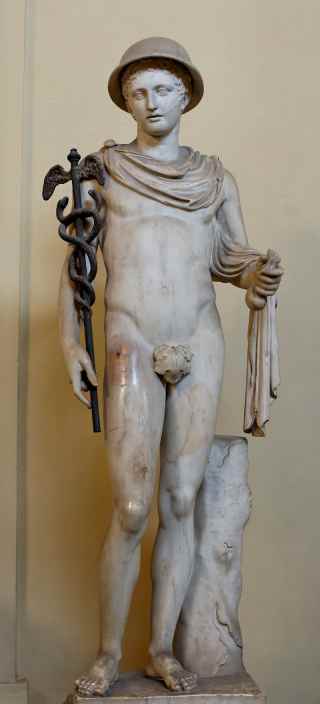 Hermes with CaduceusBy Unknown artist - Jastrow (2006), Public Domain,https://commons.wikimedia. org/w/index.php?curid=1291239 |
This is a Roman statue of Hermes carrying the caduceus and a purse, since besides being the god of thieves, he was also the god of commerce. This statue resides in the Vatican Museum and is copied from a Greek original.
The cow was another symbol of the immortal Nummo and Hermes stole 50 immortal cows from the sun god. These cows represent the same things as the caduceus symbol or the DNA of the Nummo. My research indicates that there were fifty Nummo souls lost to the Earth as a result of the events that happened here.
We see this same symbolism relating to the stolen cows in Irish Celtic stories. The 'Cattle Raid of Cooley' involved the stealing of an otherworld cow and breeding it with a mortal cow. These myths are also associated with the Jackal and the stolen fire or DNA of the Nummo, which causes humans and Nummo to lose their immortality.Shannon Dorey, The Nummo 2018 version p. 284
The "Word" was a symbol of DNA in the Dogon religion and the Sigui, symbolized the defective DNA or "Word." This society was exclusively male and represented the Jackal's birth on Earth. The Sigi so, or "language of the Sigui," was identified with the failed experiment. In Dogon society, it was considered a poor language and only contained a quarter of the vocabulary of the primary Dogon language, called, Dogo so, or "Dogon Word Language."Shannon Dorey, The Nummo p. 97
Sigui dignitaries used the Sigui language to tell the story of the creation of the universe, of human life, and of the advent of death (mortality) on Earth. They did this during funeral ceremonies and the rites of the "end of mourning," dama. The symbolism related to the Sigi so language clearly reveals the defective DNA or defective Word.Shannon Dorey, The Nummo p. 97
For more information on the Dogon religion refer to my books, The Master (Mistress) of Speech, The Nummo, Day of the Fish and The Rose.
Dogon Star Knowledge
Flaying and Venus, October 19, 2022
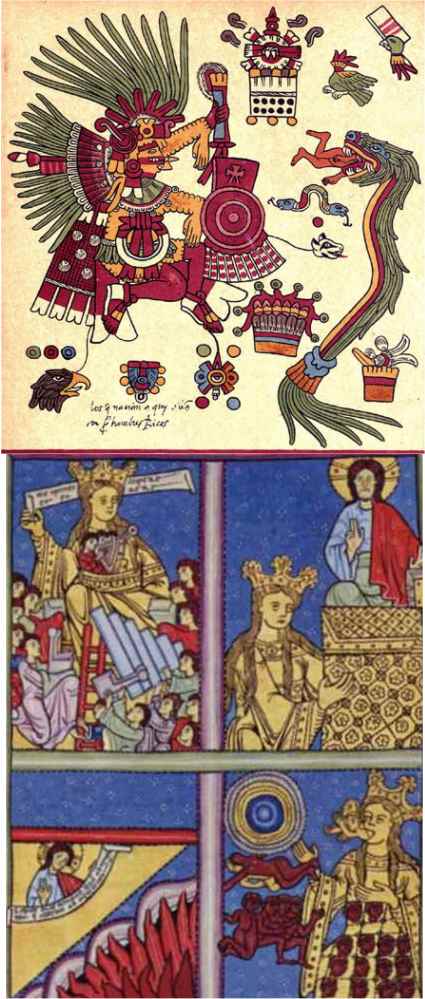 FlayingDay of the Fish p. 52 |
Skin flaying, which is an important aspect of Dogon star knowledge, is being depicted on both of these illustrations created by different cultures in different parts of the world. The top image is extracted from Page 14 of the Aztec Codex Borbonicus, which was written by Aztec priests shortly before or after the Spanish conquest of Mexico (1519-1521), and is kept at the Bibliothèque de l'Assemblée Nationale in Paris. It shows the Aztec god Xipe Totec, "Our Lord the Flayed One", who was the god of spring, vegetation, goldsmiths and silversmiths, is shown with the flayed skin draping over his arms and upper body.Day of the Fish 2022 version p. 52
The bottom image is an Illustration from Saint Hildegard's Scivias II.3, fol. 51r c. 1165-1180, from the 20th-century facsimile of the German Rupertsberg manuscript. On Saint Hildegard's image from Scivias, the figures on the bottom right section are all depicted red because their skin has been removed. The very top figure in the bottom right section still shows some skin beneath it to indicate the flaying.Day of the Fish 2022 version p. 52
Along with flaying, the swallowing and regurgitation motif is depicted on both illustrations, which the Dogon associated with a red giant star swallowing all planets and stars and then exploding or regurgiating them to create new life. Flaying is an important aspect of the Dogon religion and other ancient cultures because the planet Venus, which was associated with our second Sun, was flayed, meaning that its outer layer had been removed. This event left our Solar System with only one Sun and caused humans to lose their immortality, which is why it was such a significant event.The Rose: Dogon Star Knowledge 2022 version p. 332 .
These events also involved a black hole, which I believe is being depicted by these circular bull's eye images, which appears on both depictions.The Rose p. 332
These images clearly reveal the extreme age of the Dogon religion as the basis for the religious beliefs occurring in both of these cultures located in such different places, so far apart. Being familiar with the Dogon religion, I can spot the similarities in these drawings but someone unfamiliar with the meaning of these myths would not be aware of them.
For more information on the Dogon religion refer to my books, The Master (Mistress) of Speech, The Nummo, Day of the Fish and The Rose.
Nummo's Travelling Device
Dragon Hill and the Nummo, Nov. 16, 2018
 Dragon Hill By FrasmaconDragon Hill taken from the Uffington White Horse By Frasmacon - Own work, CC BY-SA 3.0, https://commons.wikimedia.org/ w/index.php?curid=15625695 |
Because the Nummo had a fish or serpent like tail instead of two feet like humans, they had trouble moving about on land. They had a device that the Dogon described as an iron sandal that emitted fire and allowed them to fly.Shannon Dorey, The Master of Speech, p. 23
Because the Nummo were aquatic beings, they likely had fish scales as some ancient depictions associated with them seem to suggest. Because their travelling device emitted fire, I believe that when they were flying they became associated with the mythical dragon.
We find the Nummo/dragon association in both Celtic and Chinese mythology.Shannon Dorey, The Nummo, p. 190-199 I believe that the Nummos' flying device may have been associated with Dragon Hill, a natural chalk hill with an artificial flat-top situated in Oxfordshire below the White Horse of Uffington. My research has shown a close connection between the Dogon religion and the Celtic beliefs of Europe, indicating they may have been the same religion.
A bare patch of chalk is found on top of Dragon Hill where no grass will grow.https://en.wikipedia.org/wiki/ Dragon_Hill,_Uffington Because of this, I believe this hill may have acted as a resting pad for the Nummos' travelling device. In the Dogon village, a field was left unseeded for the Nummos' flying device. This is because the device affected the villagers' crops.
Ogotemmêli said the Nummos' device could not "move out of the reserved territory" because it would scorch the millet and the village itself. Instead of using their flying devices, in areas where there were crops growing, the Nummo had to be carried on the backs of humans.
There was some suggestion that the flying device was made of iron to protect the land from the flames it emitted. According to Ogotemmêli, iron was "the colour of shade," and the sandal the Serpent wore to move about was made of iron because iron protected the soil from "feet of fire".Shannon Dorey, The Master (Mistress) of Speech, pp. 22-23
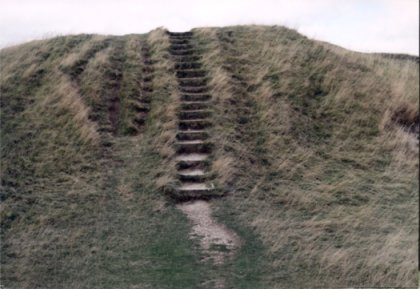 Close-up of Dragon Hill ©Robert Hill©Robert Hill |
A later legend associated with Dragon Hill, probably originating in Christianity, reported that it was on this summit that Saint George slew the dragon, and the area where nothing grows is purported to be where the dragon's blood spilled.https://en.wikipedia.org/wiki/ Dragon_Hill,_Uffington
 Wayland's Smithy©Robert HillShannon Dorey, The Nummo p. 8 |
It was suggested that the area is some sort of Iron Age ritual site associated with the nearby White Horse of Uffington. Besides the symbol of the mermaid, the Eight Nummo Ancestors were associated with centaurs especially in association with the smithy, which had important religious significance in the Dogon religion. Wayland's Smithy is also located in the same area of Oxfordshire, which is important because the Nummo were known as "Heaven's Smiths".Shannon Dorey, The Master (Mistress) of Speech, p. 23 I refer to this in The Nummo.
In the Celtic Hallstatt Culture, the Smith was identified as a dangerous wizard. According to Joseph Campbell, the Hallstatt Culture, which occupied what is now modern Germany around 900 BCE, was characterized by a gradual introduction of iron tools fashioned by a class of itinerant smiths, who in later mythic lore appear as dangerous wizards. An example can be found in the German legend of Wayland the Smith.Shannon Dorey, The Nummo, p. 7
Wayland (also Weyland, Weland, Volund, and Volundr) was the traditional Saxon god of smiths. Many places in the British Isles were associated with him, in particular Wayland's Smithy, the Neolithic burial chamber in Oxfordshire located near Swindon and Ashbury. Saxon settlers, believing it to have been made by the smith god, named the tomb Wayland's Smithy. Later, a legend grew that Wayland would re-shoe the horse of any passing traveller who left a silver penny beside the tomb.Shannon Dorey, The Nummo, p. 23
For more information on this area of England and the significance of the mounds to the Dogon religion refer to this article comparing the Chalk Mounds in England with those in the US..
For more information on the Dogon religion refer to my books, The Master (Mistress) of Speech, The Nummo, Day of the Fish and The Rose.
Nummo Had Gizzards
Thunderbirds and Nummo, Jan. 11, 2020
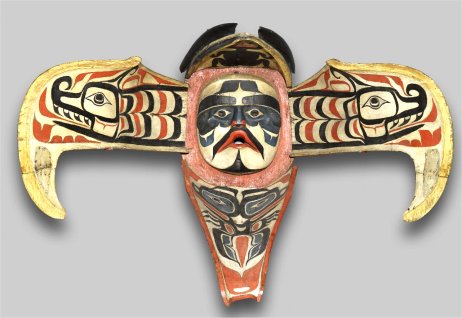 Namgis Thunderbird Maskhttps://www.brooklynmuseum.org/ opencollection/objects/19432 |
In Day of the Fish, I associate the Nummo with the Thunderbird, known to many North American Indigenous Peoples as a supernatural creature.Shannon Dorey, Day of the Fish p. 349 The Thunderbird is believed to be an Ancestral Sky Being of the Namgis clan of the Kwakwaka'wakw.
This open Thunderbird mask, which is dated to 19th c., is from Alert Bay, Vancouver Island, British Columbia, Canada, and is one of the most clever depictions I have come across in my research. To me it clearly indicates an association between the African Dogon religion and North American Indigenous beliefs.Shannon Dorey, Day of the Fish p. 321
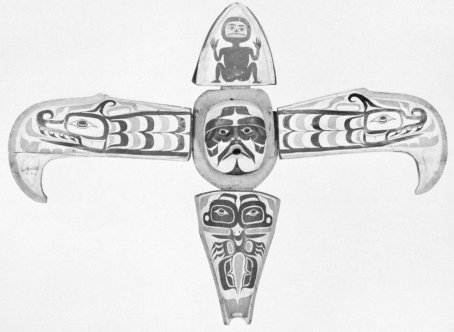 Thunderbird Mask DrawingSource Unknown |
In this sketch of the mask, we see the frog image on top, which is associated with the amphibious aspect of the Nummo, who were often associated with frogs in ancient cultures. In ancient Europe the frog was associated with the Goddess, a reflection of the Nummo, who were identified with the divine feminine. According to Gimbutas, the Sheela Na gig figure, which has been found incorporated into old churches in medieval Ireland and England was none other than the ancient frog or toad goddess, the birth giver and regeneratrix inherited from the Neolithic.Shannon Dorey, Day of the Fish pp. 53-54
The dual serpents on either side of the mask are particularly important in association with the Nummo, who were described by the Dogon people as being androgynous or "twin" Serpents.Shannon Dorey, Day of the Fish p. 349
The Thunderbird is considered a supernatural bird of power and strength. The beating of its enormous wings causes thunder, stirs up the wind, and creates storms. Sheet lighting flashes from it eyes. In masks it is depicted as many coloured, with two curling horns and often teeth within its beak.Shannon Dorey, Day of the Fish p. 349
These descriptions of the Thunderbird are like descriptions of the Nummo in their spaceship, which was associated with wind. The Dogon described a whirling wind when the ship landed. It stirred up a pile of dust and hit the ground with such a violent impact that it gave the ground its rough shape.Shannon Dorey, Day of the Fish p. 349
"Like the Nummo, the Thunderbird has horns and is 'many coloured' like the rainbow. When talking about the Nummo spaceship Griaule reported, 'His [Her] left forefoot made a black track, his [her] right a red track, the two others one green and one yellow. That fourfold track was called the 'the Nummo's track.'"Shannon Dorey, Day of the Fish p. 349
"The Nummo were shape-shifters and Thunderbirds as a species were also shape-shifters. They were associated with fire, a sun dance, and the Tree of Life. The Nummo were symbolized by the sun and dancing was important to the Dogon people because music and dancing were associated with the "first rhythm of resurrection." Like the Nummo, the Thunderbird was believed to control rainfall.Shannon Dorey, Day of the Fish p. 349
According to the Brooklyn Museum, where the mask is currently located, the figure on the bottom is also a bird and the individual wearing the mask would be covered in feathers, while dancing.https://www.brooklynmuseum.org/ opencollection/objects/19432 The Nummo were described as having gizzards like birds and the Dogon elder Ogotemmêli associated the Nummo with birds.Shannon Dorey, Day of the Fish p. 94
In the Dogon religion, an ant was identified with the first humans, and one can't help but wonder if this figure on the bottom, with its ant-like eyes, may have also been associated with an ant. Like the Nummo, the Hopi, who are descended from the Ancient Pueblo Peoples, have legends involving the "Ant People".Shannon Dorey, Day of the Fish p. 9
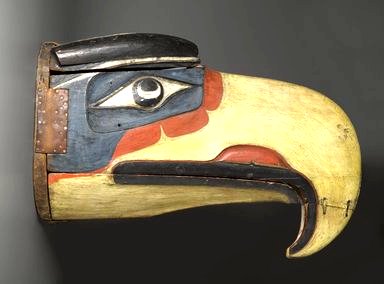 Closed Thunderbird Maskhttps://www.brooklynmuseum.org/ opencollection/objects/19432 |
When the mask is closed it depicts the Thunderbird. In the Dogon religion, the bird associated with the Mistress of Speech, who was part human and part Nummo, was the blue and white donu bird.
The donu bird was associated with resurrection and humans regaining their immortality. The human figure, in the middle of the open mask, represents this human transformation.
The mask is brilliant because not only does it describe the Nummo but it depicts the different creations found in the Dogon religion indicating that they are linked to the same source. It shows that the dual serpents and frog, which represent the Nummo, are connected to humans, identified with the figure in the centre. The bird, which appears when the mask is closed, represents the Mistress of Speech and is the ultimate form of resurrection.
I describe other bird associations in The Nummo.
Throughout the world, birds I consider to be associated with the Nummo and the Mistress of Speech are those of predominantly blue or green plumage. This includes the donu, the peacock, and the quetzal bird. In Egyptian mythology, Horus was depicted as a blue falcon. The eagle does not share this colour, but evidence indicates to me that it was associated with the Nummo and the Mistress of Speech in some cultures.Shannon Dorey, The Nummo p. 222
For more information on the Dogon religion refer to my books, The Master (Mistress) of Speech, The Nummo, Day of the Fish and The Rose.
Nummo May Have Originated On Mars
Mars and the Nummo, Dec. 17, 2019
 Curiosity"s ViewBy NASA/JPL-Caltech/MSSS - http://photojournal.jpl. nasa.gov/jpeg/PIA17944.jpg, Public Domain, https://commons.wikimedia.org /w/index.php?curid=31255689 |
This is a picture Curiosity took of the surface of Mars after crossing the "Dingo Gap" sand dune. The exploration of Mars is important because Dogon symbolism suggests that the alien Nummo may have originated on Mars.
The Dogon called the copper associated with Mars ya menu, "copper of past times." It was a symbol of permanence because it didn't die: the expression designated all ancient things that didn't end or disappear.Shannon Dorey, The Rose p. 54
According to the Dogon, when Mars was born it was made of soft copper menu olu. "The word which designated the placenta, me, came from the same root as the word copper menu. Copper was a symbol of the immortal Nummo and the sun, in comparison to iron, which symbolized mortal humans and the Earth.Shannon Dorey, The Rose p. 55
The Nummo's immortality was associated with the fact that they were androgynous or twin beings, and human mortality was associated with the fact that we are primarily single sexed beings.Shannon Dorey, The Rose p. 55 According to the Dogon, all aspects of life are interconnected and associated with suns.
The main purpose of the Dogon religion was to warn humanity about the fail-safes embedded into the universe. The Nummo were unaware of these fail-safes when they carried out an experiment that destroyed life on Mars, and ultimately left our Solar System with only one sun. The loss of our second sun caused some Nummo and eventually humans to be born mortal and single-sexed. Our lost sun and immortality, are at the heart of the Dogon religion.Shannon Dorey, The Rose p. 6
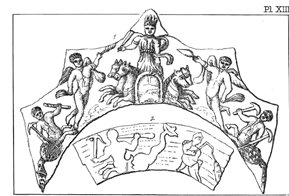 Mosaic at Lydney ParkShannon Dorey, The Rose p. 55 |
Nodens, the Fisher King of the Arthurian Legends, who was responsible for keeping the Holy Grail, was identified with the Roman god Mars. This mosaic at Lydney Park in Gloucestershire, England appears in The Rose and shows Nodens with tritons surrounded by marine monsters and fish. The Nummo were aquatic beings with fish tails. According to myth, Noden's kingdom was reduced to a barren wasteland, which would associate him with what we know about Mars.Shannon Dorey, The Rose p. 56
He was wounded in the legs and incapable of moving on his own so he spent his days fishing. Because the Nummo were fish tailed beings instead of having two feet and legs like humans, they had trouble moving on land and in some instances had to be carried on the backs of humans.Shannon Dorey, The Rose p. 55
 Mosaic at Lydney ParkExtracted from Earth/Mars comparison By Earth: NASA/Apollo 17 crewMars: ESA/MPS/UPD/LAM/IAA/RSSD/ INTA/UPM/DASP/IDA - File:The Earth seen from Apollo 17.jpgFile:OSIRIS Mars true color.jpg, Public Domain, https://commons.wikimedia.org/ w/index.php?curid=39785451 |
Scientists have determined that a catastrophic event destroyed the atmosphere on Mars about four billion years ago. Ogotemmêli indicated that the Nummo originally came to Earth because something had destroyed their world and the Earth was the only planet available to them. The Dogon believed that it was the Nummo who brought life to the Earth when they came here.Shannon Dorey, The Rose p. 56
The Nummos' association with the planet Mars likewise appears in other ancient cultures including Germanic. The day Tuesday was named after the planet Mars, which in Germanic is Tiwes, which means "twins" day. The Nummo were considered twins or dual because they were androgynous. In Dogon carvings, they were depicted with two heads, joined back to back like Janus, the Roman God of Doors.Shannon Dorey, Day of the Fish p. 132 This duality also appears on an ancient Celtic sculpture in Northern Ireland found at Caldragh Cemetery on Boa Island.Shannon Dorey, The Nummo p. 117 It likewise appears in the Tlatilco culture of Mexico, in the Lambayeque culture of Peru and elsewhere.Shannon Dorey, Day of the Fish p. 146
For more information on the Dogon religion refer to my books, The Master (Mistress) of Speech, The Nummo, Day of the Fish and The Rose.
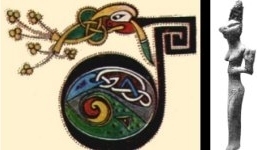
Blog Index
On this page are posts about the alien Nummo and their existence in world cultures. These posts reveal that the key figures of the Dogon religion appear all over the Earth. My research indicates that there is a spiritual component to the Dogon religion that needs to be addressed and understood. It is a spiritualism that is tied to the Earth and involves our genetic connection to our environment. It is based on vibrations that link us to the cosmos and to all life and matter in the universe.
Blog Posts
-
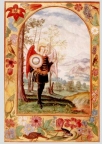 Splendour Solis
Splendour Solis
Splendour Solis -
 Anubis and Stolen Fire
Anubis and Stolen Fire
The First Human and DNA -
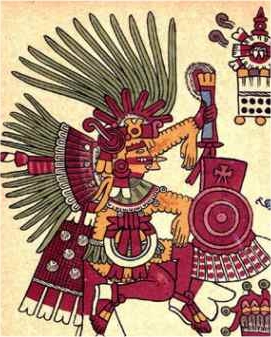 Flaying and Venus
Flaying and Venus
Dogon Star Knowledge -
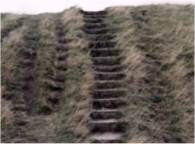 Dragon Hill
Dragon Hill
Nummo's Travelling Device -
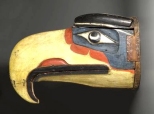 Thunderbirds and Nummo
Thunderbirds and Nummo
Nummo Had Gizzards -
 Mars and the Nummo
Mars and the Nummo
Mars and the Nummo